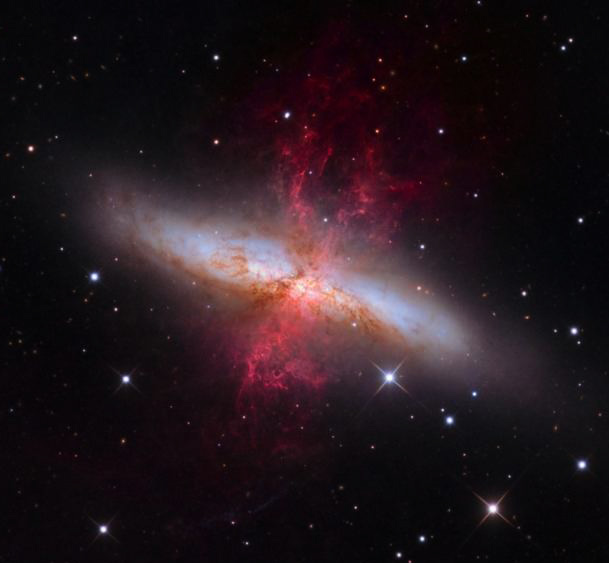Create a free profile to get unlimited access to exclusive videos, sweepstakes, and more!
Desktop Project Part 25: Chaos in a galactic nursery

[The Desktop Project is my way of a) forcing me to write something every day by 2) posting a brief article about all the astronomical images I've collected on my computer's desktop. I'm actually getting ahead of the onslaught, so I'm thinking this week may see me catching up!]
M82 is classified as an irregular galaxy -- that is, one that has no overall shape, but instead a weird, splotchy configuration. When you see a picture of it, you'll see why... and Adam Block of the Mt. Lemmon SkyCenter has a great one!
See what I mean? You can see an underlying galaxy there, but all that red stuff certainly makes it look, well, irregular.
... but wait a sec. If you look at just the galaxy (the blue stuff), it bears more than a striking resemblance to a run-of-the-mill -- if heavily warped -- edge-on spiral galaxy. And all that red stuff appears to be emanating from the center, as if its being blown from the core of the galaxy like a giant wind!
This, it so happens, is exactly what's going on. And the reason is that M82 is prolifically fecund: it's undergoing an intense burst of star formation, creating stars at a rate far exceeding that of the Milky Way.
Young stars can be extremely energetic, blowing out tremendous winds of gas. All that red stuff is actually warm hydrogen, blasting away from the center of the galaxy where all that star birth is occurring. In fact, there may be as many as 200 clusters of stars in the core of M82, in total containing tens of millions of stars. That's a lot of engines to drive out that gas. No wonder astronomers used to think the core of the galaxy was exploding! But now we know it's the opposite: it's not the deaths of thousands of stars creating that chaos, it's the births of millions of them.
So what caused this incredible profusion of new stars? M82 lies close to a bigger spiral galaxy called M81, and there's some indication they are gravitationally interacting. A near collision between the two some time ago may have stirred up the gas in M82, causing it to drop to the center of the galaxy where it became the raw material to build stars.
You might think a collision between two galaxies would result in nothing but calamity. But again, the opposite is true! In astronomy -- in everything, really -- you have to be careful about your presuppositions. The Universe doesn't care very much what you think, and will continue to behave according to the laws of nature. We're the ones who have to change and adapt to what it's telling us.
Image credit: Adam Block/Mount Lemmon SkyCenter/University of Arizona
Related Posts:
- M82 stifles a cosmic belch
- Attack of the galactic subatomic particles
- Not all halos are created equal
- In galactic collisions, might makes right
- M81, up close and personal
- Happy birthday, HST!
- Sometimes a cigar galaxy is just a cigar galaxy



























